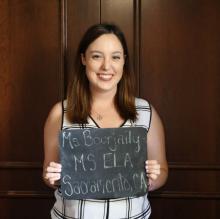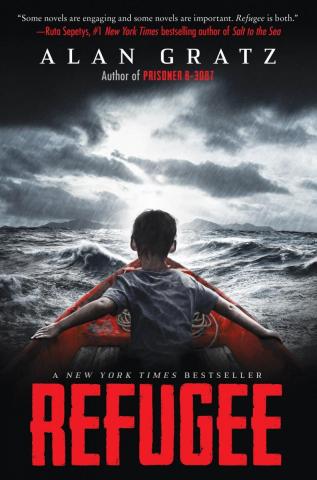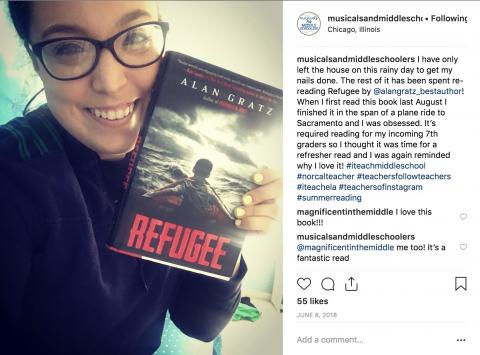Lessons in Literacy // Connecting a Middle School Classroom to the Real World through "Refugee"
 For our first installment of the Lessons in Literacy series, the CLE is pleased to spotlight an incredible educator, Anna Bourjaily. Ms. Bourjaily teaches middle school English at St. Robert Catholic School in Sacramento, California. She graduated from St. Mary's College and is serving her second year as an ACE Teaching Fellow. She is a candidate for a Master's in Education from the University of Notre Dame.
For our first installment of the Lessons in Literacy series, the CLE is pleased to spotlight an incredible educator, Anna Bourjaily. Ms. Bourjaily teaches middle school English at St. Robert Catholic School in Sacramento, California. She graduated from St. Mary's College and is serving her second year as an ACE Teaching Fellow. She is a candidate for a Master's in Education from the University of Notre Dame.
Teachers will periodically contribute to the Lessons in Literacy series on the CLE blog. Through this series, teachers will periodically share their classroom successes and innovative ideas.

One of the greatest joys I get out of teaching is helping my middle schoolers make connections between the classroom and the real world. The question "When are we going to use this?" is one I get far too often, but one that poses an excellent challenge for me in the classroom. Helping students see the impact that reading and writing can have in the real world is one of my prime motivations. One way in which I do this is through my use of social media. I love to use my "teacher Instagram," @musicalsandmiddleschoolers, to show others what our little 7th-grade classroom bubble looks like. It gives me a unique way to interact with other teachers and creates connections with my students by showing off their work.

Recently, my Instagram has been focused mostly on my use of the book Refugee by Alan Gratz, and the subsequent presentation that I had the opportunity to do at the National Council of Teachers of English Convention in Houston, TX in November. Thanks to the encouragement of my professors, I created a presentation demonstrating how influential this book can be in a middle school classroom. The book Refugee tells the story of three different children–Josef, Isabel, and Mahmoud–who are escaping their homelands in different periods of history. Josef is a Jewish boy fleeing Nazi Germany, Isabel is fleeing Castro Cuba, and Mahmoud is fleeing present-day Syria. The three main characters' stories take them across the world as they learn the importance of family and growing up in a world where they are not always welcomed. Refugee is the perfect book for middle-grade students to develop empathy for kids around the world who are of similar age and whose daily challenge is survival. The struggles these children face are quite different from those of my students. The book presents an opportunity for teachers to help their students make connections between what they read and what they observe going on in the world around them.
 I saw the book Refugee as an opportunity to tie several different skills and themes together for my 7th-grade Literature classroom. First, the book allowed my students to have an easy access point to the genre of historical fiction. They were able to recognize that historical fiction isn't just set in the past; it can be connected to what is happening in the present. The novel was the perfect way for my students to see how literature can connect to their real world.
I saw the book Refugee as an opportunity to tie several different skills and themes together for my 7th-grade Literature classroom. First, the book allowed my students to have an easy access point to the genre of historical fiction. They were able to recognize that historical fiction isn't just set in the past; it can be connected to what is happening in the present. The novel was the perfect way for my students to see how literature can connect to their real world.
In my opinion, the highlight of the entire unit was the journal project at the end. This project was meant to assess the unit's skill of showing how plot and setting can influence character development, but I also wanted to encourage students to connect their knowledge to the characters' stories. For our final project, my students followed these steps:
1. First, my students chose one of the three main characters from Refugee (Josef, Isabel, and Mahmoud).
2. From there, they needed to identify the climax of that character's story and how this event started to cause the character to undergo some sort of change. Using a journal entry format, they described the point of the story where the climax occurred and wrote about the character's thoughts and feelings at that given point in the book.
3. Then, students imagined and wrote about an event in the character's story that happened after the book ended. Students were allowed to get as creative as they wanted with the journal entry as long as they included the physical and temporal setting and demonstrated a change in the character's point of view from their first journal entry. Many of my students chose to do extra research on the time period to ensure that their second entry was historically accurate. The end result was two journal entries, both at least a page long, with a rough draft and brainstorming graphic organizer attached as well.
I was very pleased with the results of my students' projects. They dove fully into their journal entries. Many who focused on the WWII-era character, Josef, chose to research concentration camps to tell a story of a day in the life of a Jewish prisoner. The students who chose Mahmoud included their own experiences in school to tell the story of a Syrian refugee settling into a new school. Those who wrote about Isabel learned about an entirely different time and place while researching Castro-era Cuba in the 1990's. In the end, students were able to incorporate their personal experiences, their understanding of the story of Refugee, their new knowledge of historical fiction and historical time period into their journal entries. They took all of this information and meshed it with their prior knowledge of plot, setting, conflict, and point of view from our Literature unit. I was impressed that, given some guidance, my students could connect so meaningfully with stories that took place in the past and looked vastly different from their day-to-day experiences.

In this day and age of technology, it can be easy to lose that component of empathy that connects humans across time and space. I believe that it is more important than ever to ensure that our students are remaining connected to each other, to others across the world, and to others throughout history. While there are a variety of ways to do so, such as social media, literature holds the key to creating the best connections for our students. The book Refugee has allowed me to do this, and I hope it will be able to for many other teachers to come. I also hope that we begin to see more literature that can have the same impact on our students. While our students are becoming more connected with technology, it is up to teachers to ensure that the importance of empathy is conveyed, too.
Happy Reading,
Anna
